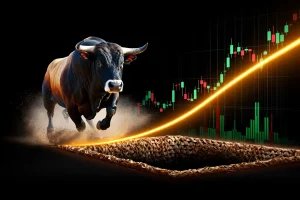Dark Psychology and Manipulation: Wall Street’s Favourite Game—You’re Just the Pawn
When the Market Becomes a Mind Game, Only the Insane Stay Sane
May 10, 2025
The Theatre of Madness
This isn’t about investing. It’s about engineered belief.
The modern market isn’t a battlefield; it’s a stage. And most traders aren’t warriors—they’re unpaid actors in someone else’s psychodrama. The chaos you see? That’s not a glitch. It’s choreography. Panic cycles, false serenity, RSI readings that scream “buy” right before the floor collapses—none of this is accidental. It’s dramaturgy, and the only crime is believing it’s organic.
The key to this play is noise. Crank the volume high enough, and pattern recognition fails. Algorithms start chasing shadows. Traders fall into micro-cycles—bullish Monday, bearish Thursday, euphoric by Friday’s close—rinsed and spun like laundry. Meanwhile, the architects already know where this week ends. They’ve mapped the behavioural trigger points and set the traps.
II. Information Overload as Psychological Warfare
You were never meant to think clearly. That’s the point.
The deluge of media, the “breaking news” tickers, the firehose of opinion disguised as insight—it’s all fertiliser for belief inertia. Flood the brain, and it defaults to narrative. The average investor doesn’t analyse; they anchor. They cling to what felt right last time. But last time was a decoy, too.
This isn’t a conspiracy. It’s architecture. Belief loops are profitable. Emotional fragmentation makes you sell cheap and buy high. All the “analysis” tools, curated feeds, and digestible infographics are not for illumination. They’re anaesthetised. Keep you sedated while your pockets are emptied.
III. The Machine: Division, Control, Execution
Call it what you like: propaganda, dark psychology, or the fine art of distraction.
The system doesn’t need your loyalty. It just needs your attention—scattered, polarised, weaponised against itself. Welcome to the Division Machine. Left vs. right, growth vs. value, bulls vs. bears—binary cages for a non-binary world.
Look closer: the same hedge funds play both sides. The same banks bet on collapse while preaching stability. Remember 2020? Apocalyptic headlines slammed your feed while buy desks at BlackRock loaded up on blue chips. You were told to panic. They were told to prepare.
False breakouts, option pinning, orchestrated RSI spikes—each one a blade in the psychological gauntlet. It’s not about moving price. It’s about moving belief. Break a trader’s rhythm long enough, and they’ll follow anything that promises clarity. Enter: influencers, TikTok gurus, macro strategists who speak in riddles. Every layer, another signal jammed with noise.
IV. Modified Helplessness: The Real Pandemic
You’re not here to be fair. You’re here to win. That means seeing through the fog—not waiting for it to lift
You’ve heard of learned helplessness. But what you’re seeing now is its mutant cousin: modified helplessness.
It’s not surrender. It’s a feedback loop.
The investor doesn’t give up—they double down on delusion. They know something feels wrong, but instead of exiting the maze, they search for deeper meaning in the trap. The trend line becomes a lifeline. A bullish MACD crossover? Salvation. A death cross? Damnation.
But both signals are often engineered by those with the power to paint the tape. False breakdowns triggered at key volume points. Sudden reversals into expiry. It’s not a technical failure—it’s a precision strike. And the retail crowd? Still convinced it’s just “volatility.”
V. The Pin and the Pain
Here’s where the gloves come off.
The options market is a bloodsport masquerading as hedging. Pinning prices near maximum pain isn’t an anomaly—it’s sport. Think back to that Friday close when your calls were just out-of-the-money. Not a coincidence. A harvest.
Market makers know where your pain thresholds are because you told them. Your orders are public record. Your stops are GPS coordinates.
They draw you in with controlled breakouts. Shallow volume. Just enough to trip your indicators and trigger your greed. Then the rug gets pulled. You’re not trading—you’re reacting. Reflexively. Predictably.
VI. Cultural Conditioning: The Hidden Algorithm
Most forget: markets are downstream from culture.
How we think about success, risk, and fear is inherited. Instagram flexes, CNBC confidence theatre, financial literacy influencers who learned everything last week. It’s all noise that rewires your expectation loop. You begin to believe your feelings have predictive power. But those feelings are not yours—they were installed.
And so, you “invest emotionally.” You chase narratives instead of structure. You follow momentum that was built to be reversed. Welcome to the monetisation of delusion.
VII. Escape Isn’t External—It’s Cognitive
There’s no “safe” strategy. No one-size-fits-all “alpha.”
The real edge isn’t predictive—it’s perceptive.
It’s the ability to zoom out when everyone’s zoomed in.
It’s seeing the market not as a mystery, but a mirror.
Want to win like a bandit? Don’t chase the next big move. Watch who’s engineering the next big mood.
What’s your RSI doing? Who cares. Ask instead: Who benefits from me acting on this signal?
What does the MACD say? Wrong question. Ask: What story is the chart trying to sell me right now, and why?
Every signal is a Trojan horse. Open it up, and what you’ll find isn’t insight—it’s intention.
VIII. The Quiet Exit Strategy
Here’s the trick to walking out of the psychological warzone without getting shot in the back: go quiet.
No grand exits. No Reddit confessions. You detach, not because you’re cynical, but because you’re clear.
You trade less. You wait longer.
You ignore the false prophets and the flashing indicators.
Most importantly, you study pain like a scientist, your own and others’. You map it, anticipate it, and use it.
Because those who learn to navigate pain, not flee from it, are the ones who profit when the next trap is sprung.
Final Vector: Escape the Maze, Torch the Map
This game was never fair. It was rigged from the start, stitched together by invisible hands who learned to weaponise human pattern-seeking. Panic? Orchestrated. Euphoria? Bottled and sold. Confusion? The default operating system. But here’s the kicker: you can’t unsee it once you see it. The charts aren’t signals—they’re snares. The headlines aren’t news—they’re narcotics. And the average investor? A dopamine junkie chasing ghost breakouts while sharks feast on his hesitation.
But you? You’re here. And that changes everything.
The edge now isn’t IQ or some secret indicator. It’s psychological sovereignty. It’s standing above the gameboard while the pawns scream about Fed pivots and CPI prints. It’s trading like a ghost—untrackable, unemotional, unseduced by bait.
Break the loop. Detach from the stimulus. Treat every chart like a rigged roulette wheel and every narrative like it’s loaded with cyanide.
Because when you stop reacting, you start engineering. You stop being cattle and become a bandit—silent, sharp, surgical. You don’t fight the system. You exploit its rhythms, hijack its signals, and vanish before the smoke clears.
That’s the only real edge in this rigged dark psychology and manipulation maze.
Not knowledge. Not a prediction. But freedom of mind—and the guts to act on it.
Don’t look for answers. Look for fingerprints. The market doesn’t lie—it just speaks in code. Break the code, and the noise becomes music.
And music? That’s when you dance—while the rest panic.













